Human Resource Management Report: Reward System Analysis
VerifiedAdded on 2020/06/04
|13
|3352
|216
Report
AI Summary
This report provides a comprehensive overview of Human Resource Management (HRM), focusing on the critical role of the total reward system in motivating employees and enhancing organizational performance. The report delves into the concept of total reward, explaining its connection with employee performance and highlighting its function as a motivational strategy. It explores various types of rewards, including monetary and non-monetary incentives, and examines their impact on employee engagement. Furthermore, the report connects the total reward system with motivational theories, particularly Maslow's Hierarchy of Needs, to illustrate how different reward strategies cater to various employee needs. The report then applies these concepts to two distinct sectors: the supermarket industry (Tesco) and the airline industry, demonstrating how reward schemes are implemented and their effects on employees and stakeholders. The report also discusses the challenges in evaluating the impact of reward schemes and concludes by highlighting the positive but varied roles that reward schemes play in these sectors. This report is a valuable resource for students studying HRM, offering insights into effective reward strategies and their real-world applications.
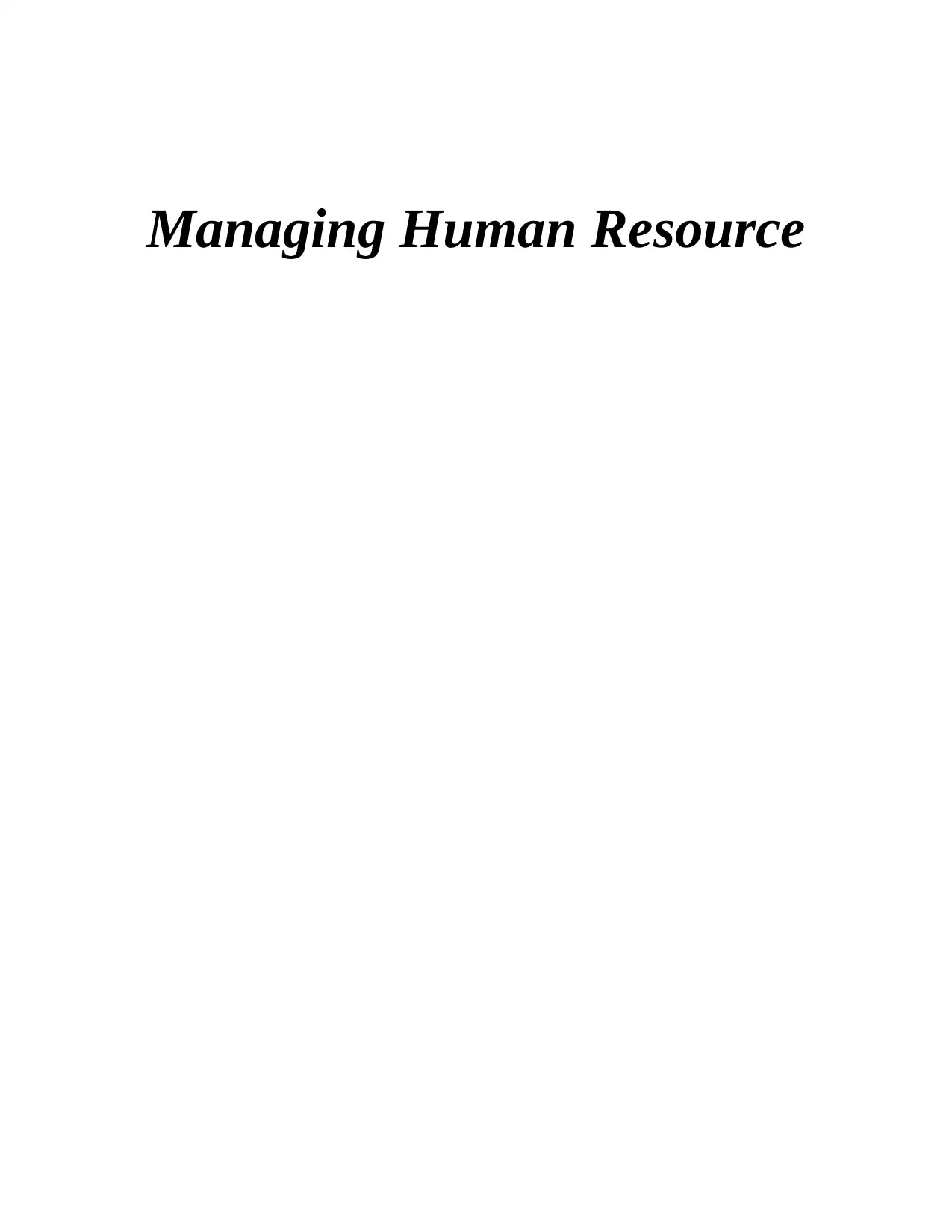
Managing Human Resource
Paraphrase This Document
Need a fresh take? Get an instant paraphrase of this document with our AI Paraphraser
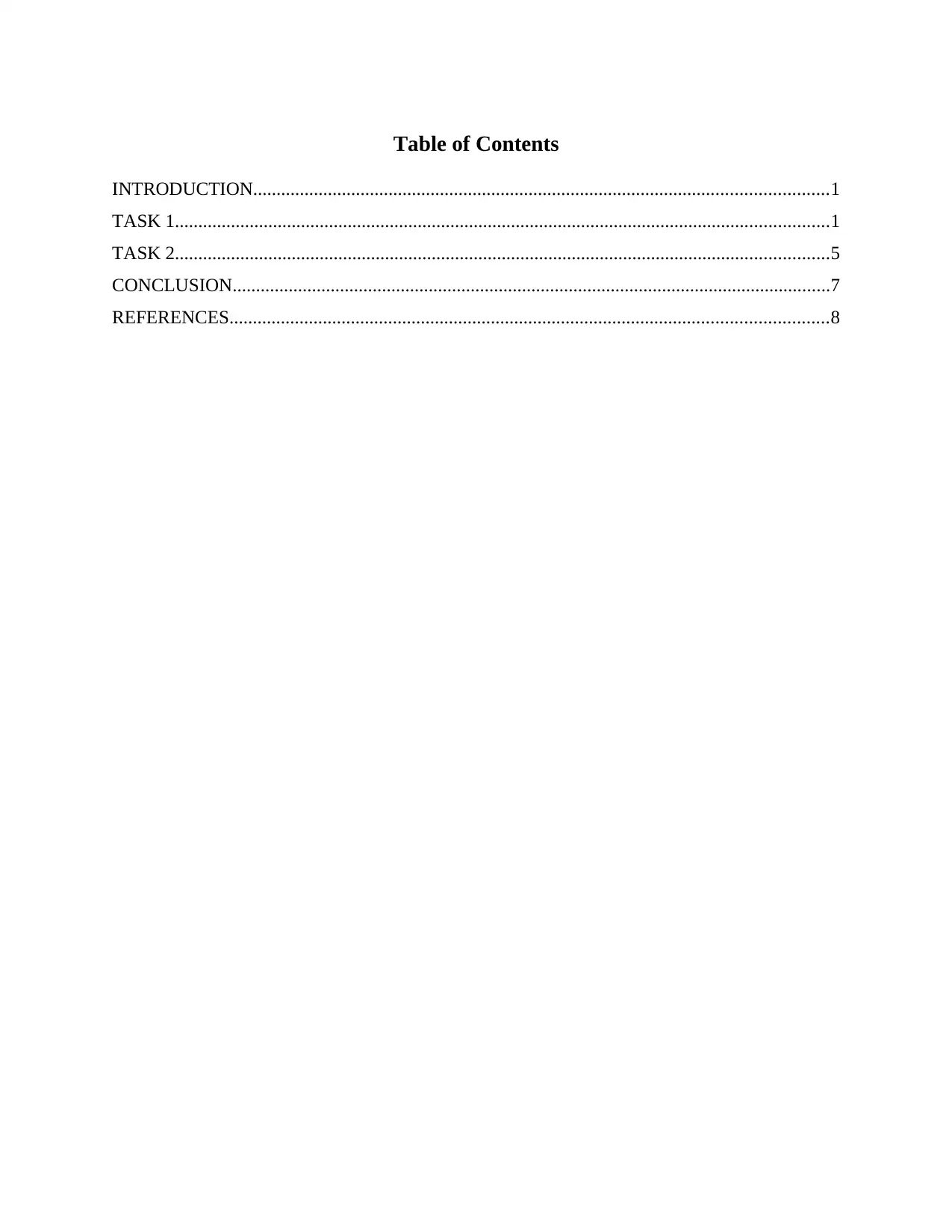
Table of Contents
INTRODUCTION...........................................................................................................................1
TASK 1............................................................................................................................................1
TASK 2............................................................................................................................................5
CONCLUSION................................................................................................................................7
REFERENCES................................................................................................................................8
INTRODUCTION...........................................................................................................................1
TASK 1............................................................................................................................................1
TASK 2............................................................................................................................................5
CONCLUSION................................................................................................................................7
REFERENCES................................................................................................................................8
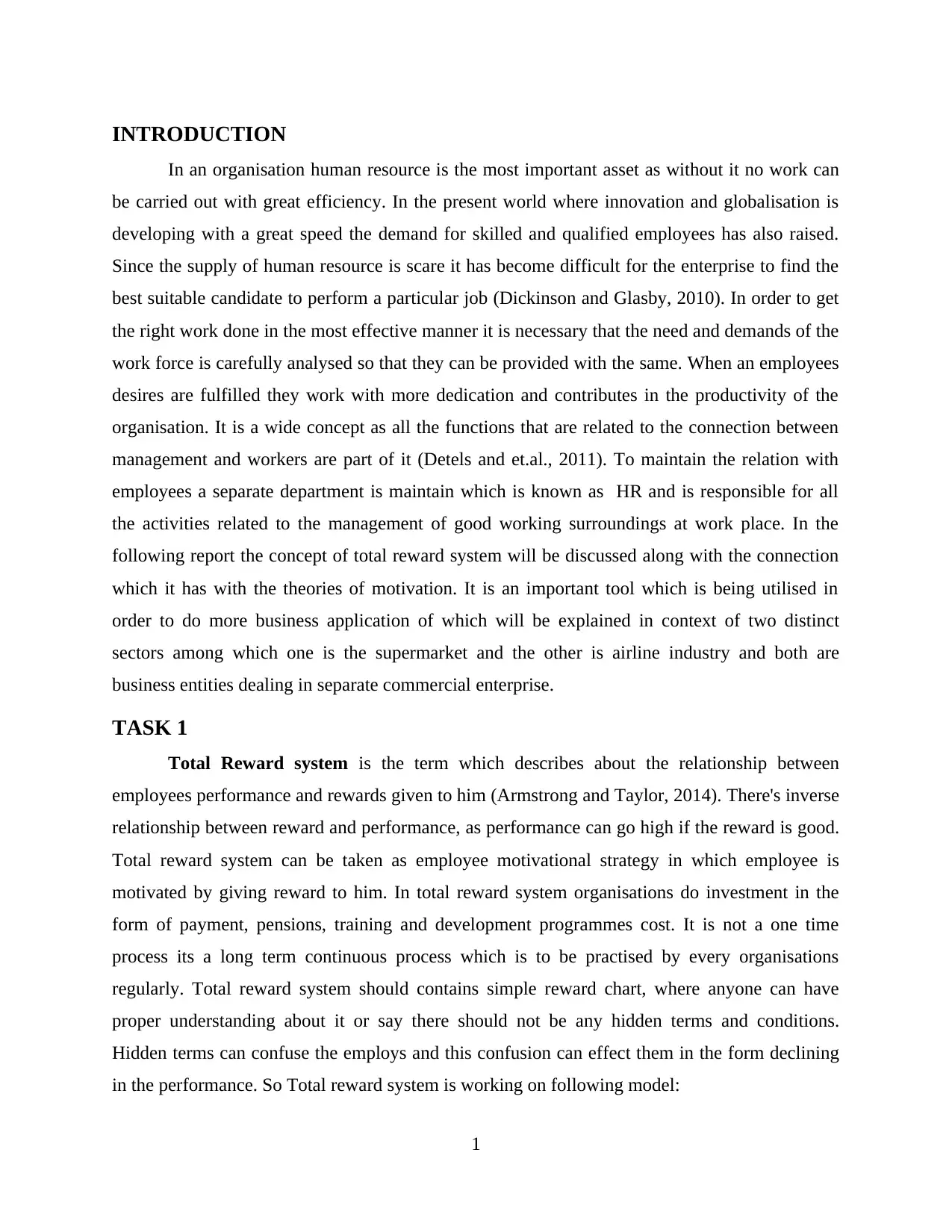
INTRODUCTION
In an organisation human resource is the most important asset as without it no work can
be carried out with great efficiency. In the present world where innovation and globalisation is
developing with a great speed the demand for skilled and qualified employees has also raised.
Since the supply of human resource is scare it has become difficult for the enterprise to find the
best suitable candidate to perform a particular job (Dickinson and Glasby, 2010). In order to get
the right work done in the most effective manner it is necessary that the need and demands of the
work force is carefully analysed so that they can be provided with the same. When an employees
desires are fulfilled they work with more dedication and contributes in the productivity of the
organisation. It is a wide concept as all the functions that are related to the connection between
management and workers are part of it (Detels and et.al., 2011). To maintain the relation with
employees a separate department is maintain which is known as HR and is responsible for all
the activities related to the management of good working surroundings at work place. In the
following report the concept of total reward system will be discussed along with the connection
which it has with the theories of motivation. It is an important tool which is being utilised in
order to do more business application of which will be explained in context of two distinct
sectors among which one is the supermarket and the other is airline industry and both are
business entities dealing in separate commercial enterprise.
TASK 1
Total Reward system is the term which describes about the relationship between
employees performance and rewards given to him (Armstrong and Taylor, 2014). There's inverse
relationship between reward and performance, as performance can go high if the reward is good.
Total reward system can be taken as employee motivational strategy in which employee is
motivated by giving reward to him. In total reward system organisations do investment in the
form of payment, pensions, training and development programmes cost. It is not a one time
process its a long term continuous process which is to be practised by every organisations
regularly. Total reward system should contains simple reward chart, where anyone can have
proper understanding about it or say there should not be any hidden terms and conditions.
Hidden terms can confuse the employs and this confusion can effect them in the form declining
in the performance. So Total reward system is working on following model:
1
In an organisation human resource is the most important asset as without it no work can
be carried out with great efficiency. In the present world where innovation and globalisation is
developing with a great speed the demand for skilled and qualified employees has also raised.
Since the supply of human resource is scare it has become difficult for the enterprise to find the
best suitable candidate to perform a particular job (Dickinson and Glasby, 2010). In order to get
the right work done in the most effective manner it is necessary that the need and demands of the
work force is carefully analysed so that they can be provided with the same. When an employees
desires are fulfilled they work with more dedication and contributes in the productivity of the
organisation. It is a wide concept as all the functions that are related to the connection between
management and workers are part of it (Detels and et.al., 2011). To maintain the relation with
employees a separate department is maintain which is known as HR and is responsible for all
the activities related to the management of good working surroundings at work place. In the
following report the concept of total reward system will be discussed along with the connection
which it has with the theories of motivation. It is an important tool which is being utilised in
order to do more business application of which will be explained in context of two distinct
sectors among which one is the supermarket and the other is airline industry and both are
business entities dealing in separate commercial enterprise.
TASK 1
Total Reward system is the term which describes about the relationship between
employees performance and rewards given to him (Armstrong and Taylor, 2014). There's inverse
relationship between reward and performance, as performance can go high if the reward is good.
Total reward system can be taken as employee motivational strategy in which employee is
motivated by giving reward to him. In total reward system organisations do investment in the
form of payment, pensions, training and development programmes cost. It is not a one time
process its a long term continuous process which is to be practised by every organisations
regularly. Total reward system should contains simple reward chart, where anyone can have
proper understanding about it or say there should not be any hidden terms and conditions.
Hidden terms can confuse the employs and this confusion can effect them in the form declining
in the performance. So Total reward system is working on following model:
1
⊘ This is a preview!⊘
Do you want full access?
Subscribe today to unlock all pages.

Trusted by 1+ million students worldwide
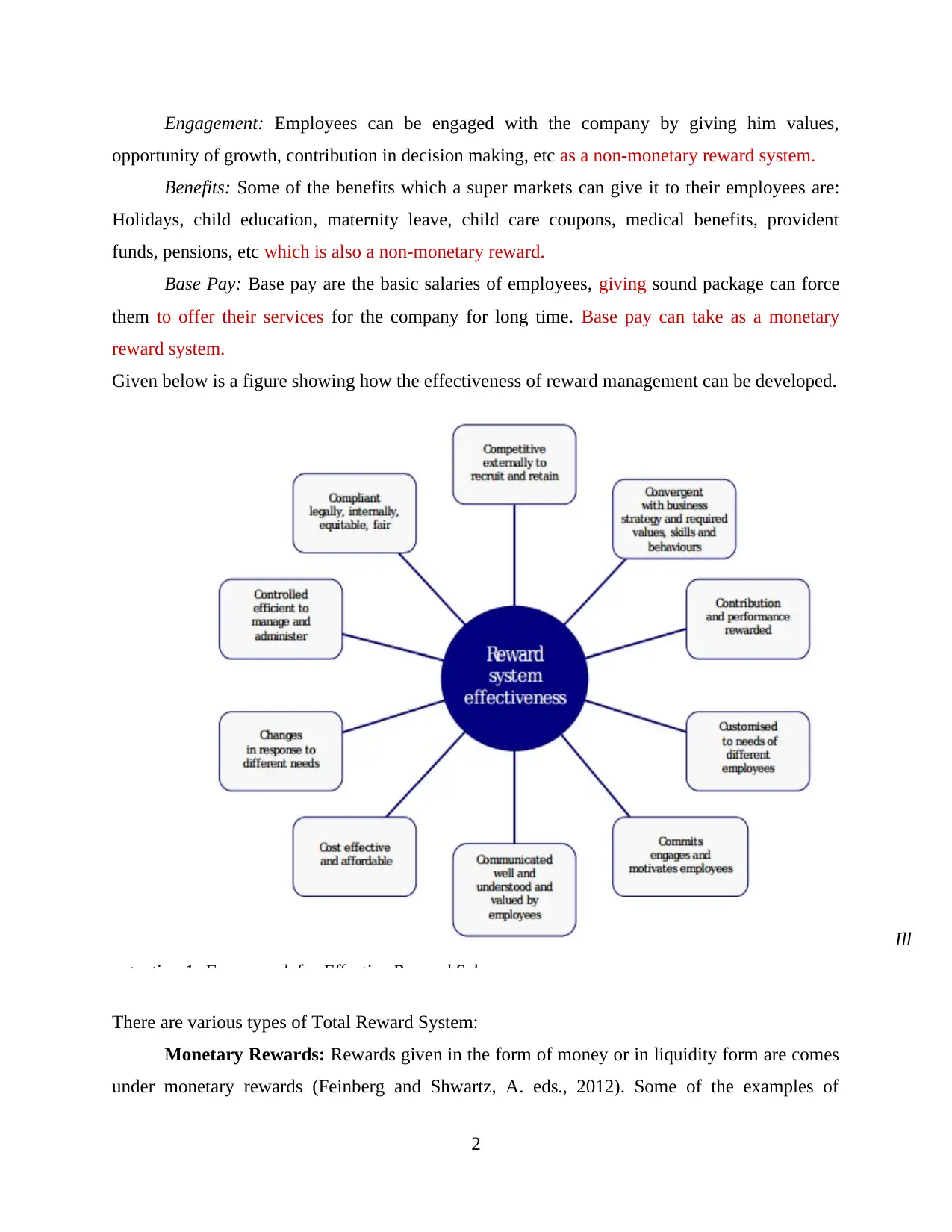
Engagement: Employees can be engaged with the company by giving him values,
opportunity of growth, contribution in decision making, etc as a non-monetary reward system.
Benefits: Some of the benefits which a super markets can give it to their employees are:
Holidays, child education, maternity leave, child care coupons, medical benefits, provident
funds, pensions, etc which is also a non-monetary reward.
Base Pay: Base pay are the basic salaries of employees, giving sound package can force
them to offer their services for the company for long time. Base pay can take as a monetary
reward system.
Given below is a figure showing how the effectiveness of reward management can be developed.
Ill
ustration 1: Framework for Effective Reward Schemes
There are various types of Total Reward System:
Monetary Rewards: Rewards given in the form of money or in liquidity form are comes
under monetary rewards (Feinberg and Shwartz, A. eds., 2012). Some of the examples of
2
opportunity of growth, contribution in decision making, etc as a non-monetary reward system.
Benefits: Some of the benefits which a super markets can give it to their employees are:
Holidays, child education, maternity leave, child care coupons, medical benefits, provident
funds, pensions, etc which is also a non-monetary reward.
Base Pay: Base pay are the basic salaries of employees, giving sound package can force
them to offer their services for the company for long time. Base pay can take as a monetary
reward system.
Given below is a figure showing how the effectiveness of reward management can be developed.
Ill
ustration 1: Framework for Effective Reward Schemes
There are various types of Total Reward System:
Monetary Rewards: Rewards given in the form of money or in liquidity form are comes
under monetary rewards (Feinberg and Shwartz, A. eds., 2012). Some of the examples of
2
Paraphrase This Document
Need a fresh take? Get an instant paraphrase of this document with our AI Paraphraser
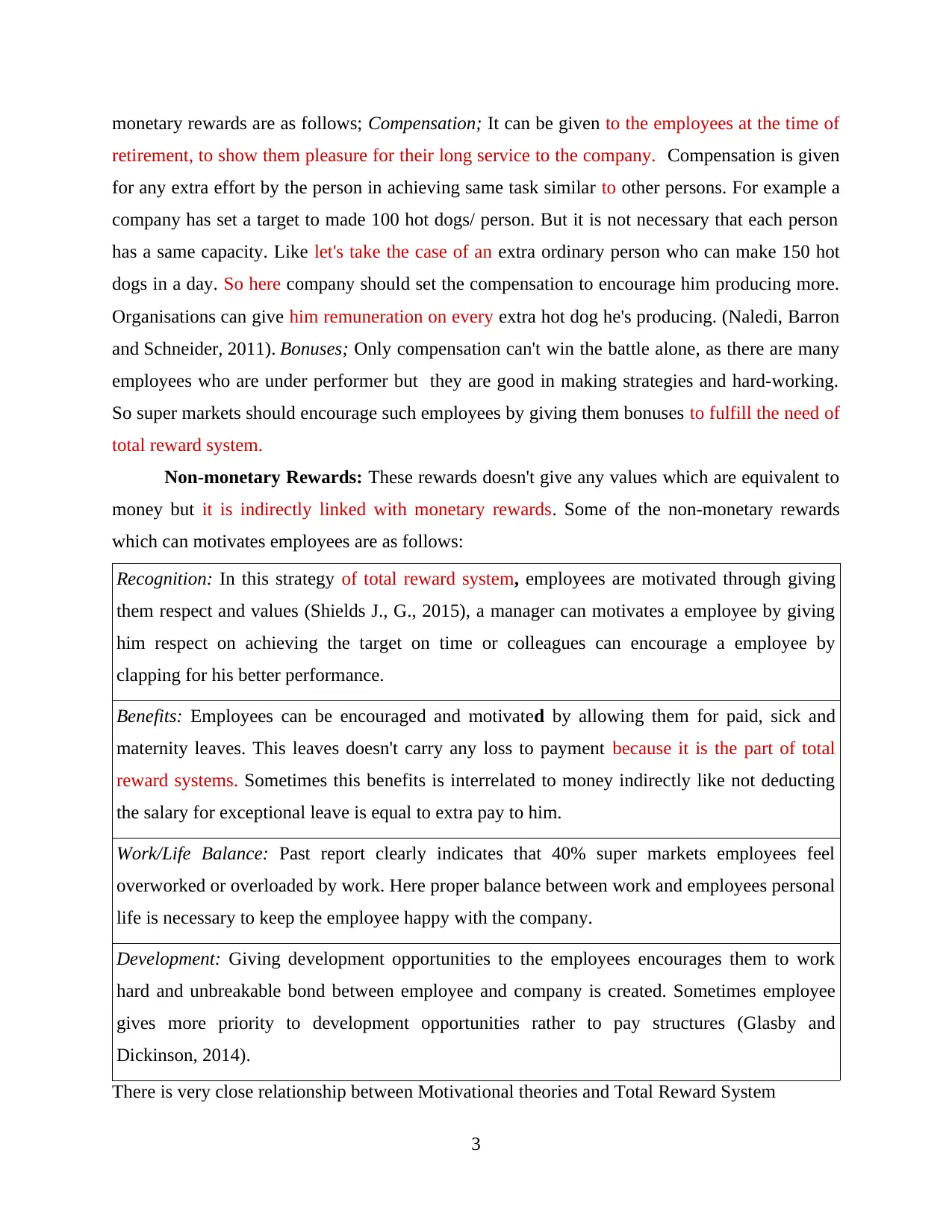
monetary rewards are as follows; Compensation; It can be given to the employees at the time of
retirement, to show them pleasure for their long service to the company. Compensation is given
for any extra effort by the person in achieving same task similar to other persons. For example a
company has set a target to made 100 hot dogs/ person. But it is not necessary that each person
has a same capacity. Like let's take the case of an extra ordinary person who can make 150 hot
dogs in a day. So here company should set the compensation to encourage him producing more.
Organisations can give him remuneration on every extra hot dog he's producing. (Naledi, Barron
and Schneider, 2011). Bonuses; Only compensation can't win the battle alone, as there are many
employees who are under performer but they are good in making strategies and hard-working.
So super markets should encourage such employees by giving them bonuses to fulfill the need of
total reward system.
Non-monetary Rewards: These rewards doesn't give any values which are equivalent to
money but it is indirectly linked with monetary rewards. Some of the non-monetary rewards
which can motivates employees are as follows:
Recognition: In this strategy of total reward system, employees are motivated through giving
them respect and values (Shields J., G., 2015), a manager can motivates a employee by giving
him respect on achieving the target on time or colleagues can encourage a employee by
clapping for his better performance.
Benefits: Employees can be encouraged and motivated by allowing them for paid, sick and
maternity leaves. This leaves doesn't carry any loss to payment because it is the part of total
reward systems. Sometimes this benefits is interrelated to money indirectly like not deducting
the salary for exceptional leave is equal to extra pay to him.
Work/Life Balance: Past report clearly indicates that 40% super markets employees feel
overworked or overloaded by work. Here proper balance between work and employees personal
life is necessary to keep the employee happy with the company.
Development: Giving development opportunities to the employees encourages them to work
hard and unbreakable bond between employee and company is created. Sometimes employee
gives more priority to development opportunities rather to pay structures (Glasby and
Dickinson, 2014).
There is very close relationship between Motivational theories and Total Reward System
3
retirement, to show them pleasure for their long service to the company. Compensation is given
for any extra effort by the person in achieving same task similar to other persons. For example a
company has set a target to made 100 hot dogs/ person. But it is not necessary that each person
has a same capacity. Like let's take the case of an extra ordinary person who can make 150 hot
dogs in a day. So here company should set the compensation to encourage him producing more.
Organisations can give him remuneration on every extra hot dog he's producing. (Naledi, Barron
and Schneider, 2011). Bonuses; Only compensation can't win the battle alone, as there are many
employees who are under performer but they are good in making strategies and hard-working.
So super markets should encourage such employees by giving them bonuses to fulfill the need of
total reward system.
Non-monetary Rewards: These rewards doesn't give any values which are equivalent to
money but it is indirectly linked with monetary rewards. Some of the non-monetary rewards
which can motivates employees are as follows:
Recognition: In this strategy of total reward system, employees are motivated through giving
them respect and values (Shields J., G., 2015), a manager can motivates a employee by giving
him respect on achieving the target on time or colleagues can encourage a employee by
clapping for his better performance.
Benefits: Employees can be encouraged and motivated by allowing them for paid, sick and
maternity leaves. This leaves doesn't carry any loss to payment because it is the part of total
reward systems. Sometimes this benefits is interrelated to money indirectly like not deducting
the salary for exceptional leave is equal to extra pay to him.
Work/Life Balance: Past report clearly indicates that 40% super markets employees feel
overworked or overloaded by work. Here proper balance between work and employees personal
life is necessary to keep the employee happy with the company.
Development: Giving development opportunities to the employees encourages them to work
hard and unbreakable bond between employee and company is created. Sometimes employee
gives more priority to development opportunities rather to pay structures (Glasby and
Dickinson, 2014).
There is very close relationship between Motivational theories and Total Reward System
3
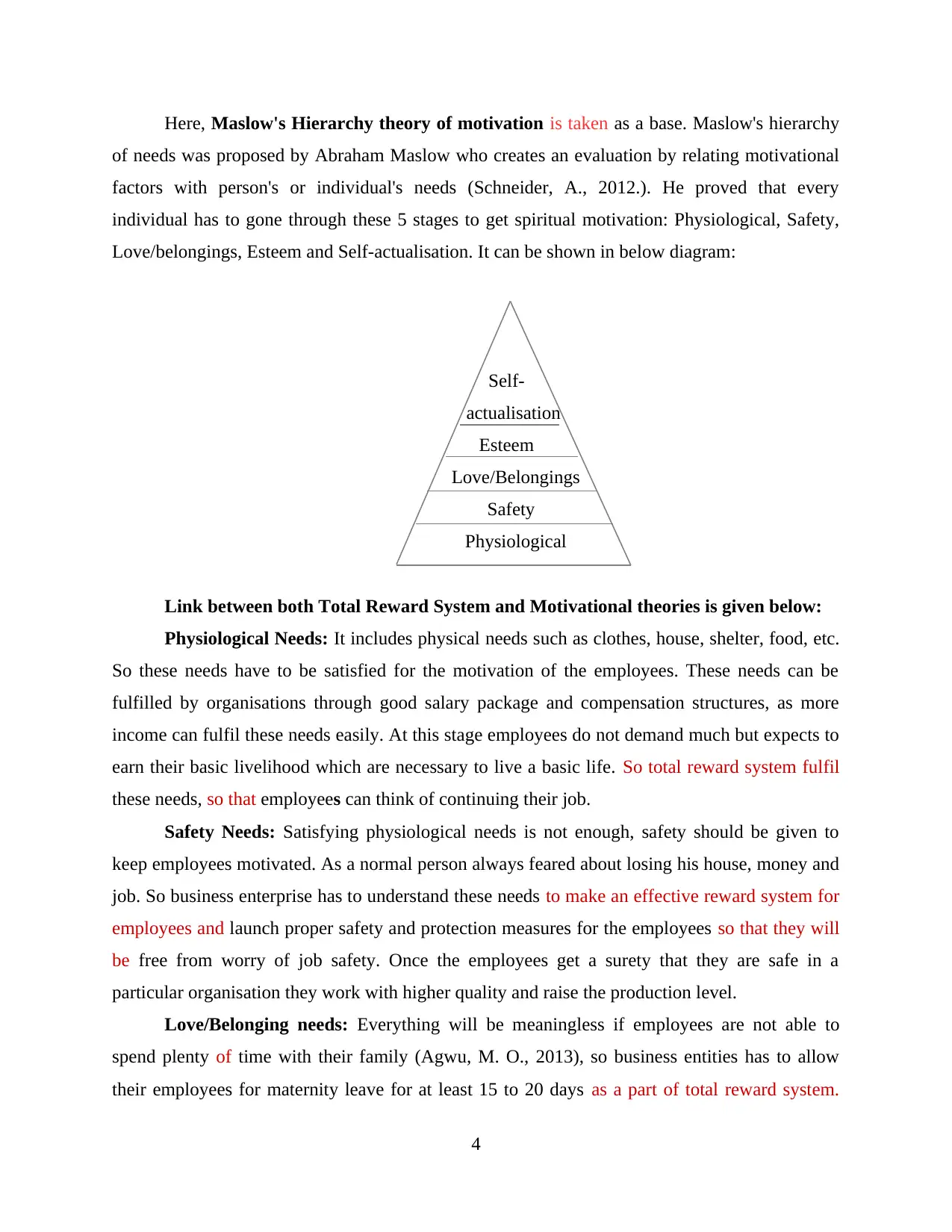
Here, Maslow's Hierarchy theory of motivation is taken as a base. Maslow's hierarchy
of needs was proposed by Abraham Maslow who creates an evaluation by relating motivational
factors with person's or individual's needs (Schneider, A., 2012.). He proved that every
individual has to gone through these 5 stages to get spiritual motivation: Physiological, Safety,
Love/belongings, Esteem and Self-actualisation. It can be shown in below diagram:
Self-
actualisation
Esteem
Love/Belongings
Safety
Physiological
Link between both Total Reward System and Motivational theories is given below:
Physiological Needs: It includes physical needs such as clothes, house, shelter, food, etc.
So these needs have to be satisfied for the motivation of the employees. These needs can be
fulfilled by organisations through good salary package and compensation structures, as more
income can fulfil these needs easily. At this stage employees do not demand much but expects to
earn their basic livelihood which are necessary to live a basic life. So total reward system fulfil
these needs, so that employees can think of continuing their job.
Safety Needs: Satisfying physiological needs is not enough, safety should be given to
keep employees motivated. As a normal person always feared about losing his house, money and
job. So business enterprise has to understand these needs to make an effective reward system for
employees and launch proper safety and protection measures for the employees so that they will
be free from worry of job safety. Once the employees get a surety that they are safe in a
particular organisation they work with higher quality and raise the production level.
Love/Belonging needs: Everything will be meaningless if employees are not able to
spend plenty of time with their family (Agwu, M. O., 2013), so business entities has to allow
their employees for maternity leave for at least 15 to 20 days as a part of total reward system.
4
of needs was proposed by Abraham Maslow who creates an evaluation by relating motivational
factors with person's or individual's needs (Schneider, A., 2012.). He proved that every
individual has to gone through these 5 stages to get spiritual motivation: Physiological, Safety,
Love/belongings, Esteem and Self-actualisation. It can be shown in below diagram:
Self-
actualisation
Esteem
Love/Belongings
Safety
Physiological
Link between both Total Reward System and Motivational theories is given below:
Physiological Needs: It includes physical needs such as clothes, house, shelter, food, etc.
So these needs have to be satisfied for the motivation of the employees. These needs can be
fulfilled by organisations through good salary package and compensation structures, as more
income can fulfil these needs easily. At this stage employees do not demand much but expects to
earn their basic livelihood which are necessary to live a basic life. So total reward system fulfil
these needs, so that employees can think of continuing their job.
Safety Needs: Satisfying physiological needs is not enough, safety should be given to
keep employees motivated. As a normal person always feared about losing his house, money and
job. So business enterprise has to understand these needs to make an effective reward system for
employees and launch proper safety and protection measures for the employees so that they will
be free from worry of job safety. Once the employees get a surety that they are safe in a
particular organisation they work with higher quality and raise the production level.
Love/Belonging needs: Everything will be meaningless if employees are not able to
spend plenty of time with their family (Agwu, M. O., 2013), so business entities has to allow
their employees for maternity leave for at least 15 to 20 days as a part of total reward system.
4
⊘ This is a preview!⊘
Do you want full access?
Subscribe today to unlock all pages.

Trusted by 1+ million students worldwide
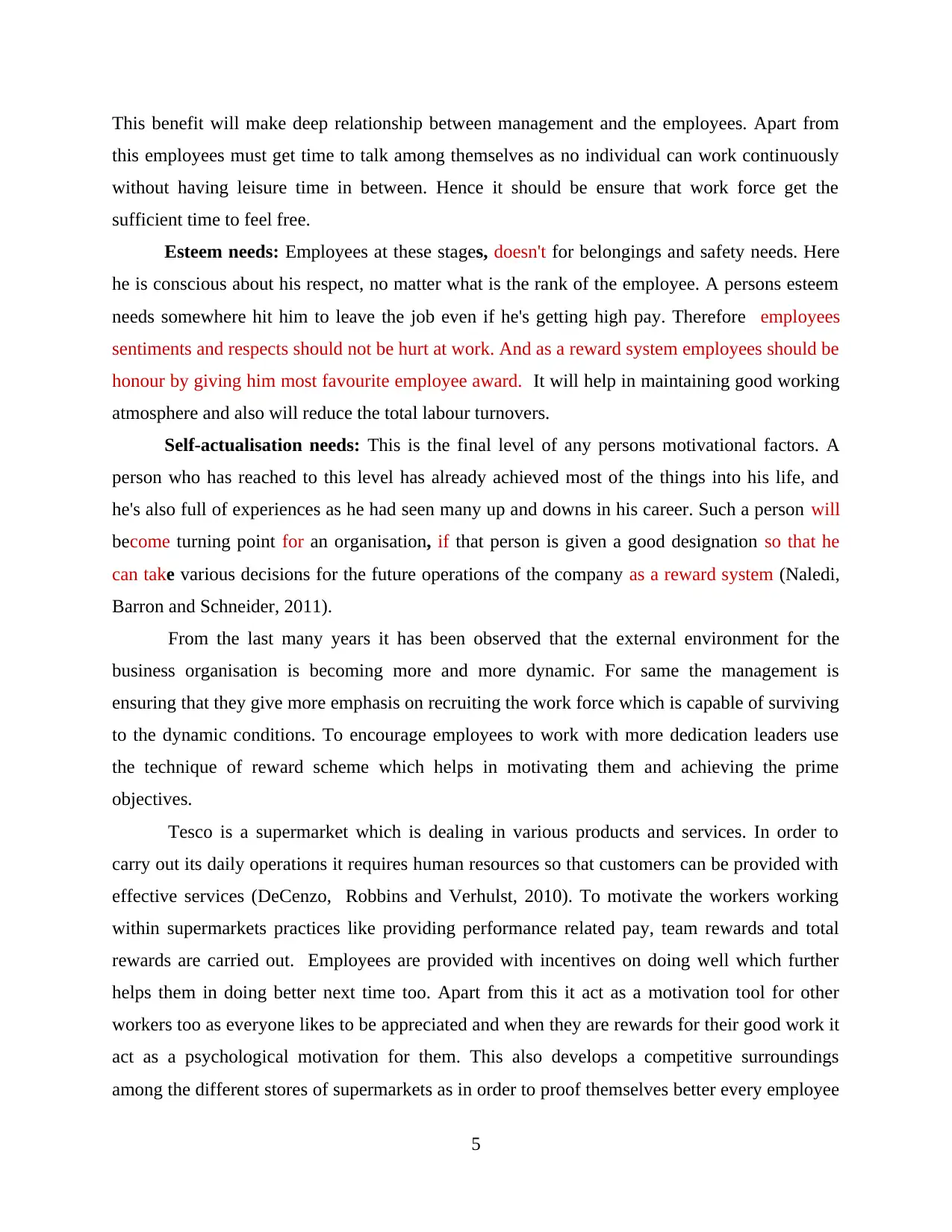
This benefit will make deep relationship between management and the employees. Apart from
this employees must get time to talk among themselves as no individual can work continuously
without having leisure time in between. Hence it should be ensure that work force get the
sufficient time to feel free.
Esteem needs: Employees at these stages, doesn't for belongings and safety needs. Here
he is conscious about his respect, no matter what is the rank of the employee. A persons esteem
needs somewhere hit him to leave the job even if he's getting high pay. Therefore employees
sentiments and respects should not be hurt at work. And as a reward system employees should be
honour by giving him most favourite employee award. It will help in maintaining good working
atmosphere and also will reduce the total labour turnovers.
Self-actualisation needs: This is the final level of any persons motivational factors. A
person who has reached to this level has already achieved most of the things into his life, and
he's also full of experiences as he had seen many up and downs in his career. Such a person will
become turning point for an organisation, if that person is given a good designation so that he
can take various decisions for the future operations of the company as a reward system (Naledi,
Barron and Schneider, 2011).
From the last many years it has been observed that the external environment for the
business organisation is becoming more and more dynamic. For same the management is
ensuring that they give more emphasis on recruiting the work force which is capable of surviving
to the dynamic conditions. To encourage employees to work with more dedication leaders use
the technique of reward scheme which helps in motivating them and achieving the prime
objectives.
Tesco is a supermarket which is dealing in various products and services. In order to
carry out its daily operations it requires human resources so that customers can be provided with
effective services (DeCenzo, Robbins and Verhulst, 2010). To motivate the workers working
within supermarkets practices like providing performance related pay, team rewards and total
rewards are carried out. Employees are provided with incentives on doing well which further
helps them in doing better next time too. Apart from this it act as a motivation tool for other
workers too as everyone likes to be appreciated and when they are rewards for their good work it
act as a psychological motivation for them. This also develops a competitive surroundings
among the different stores of supermarkets as in order to proof themselves better every employee
5
this employees must get time to talk among themselves as no individual can work continuously
without having leisure time in between. Hence it should be ensure that work force get the
sufficient time to feel free.
Esteem needs: Employees at these stages, doesn't for belongings and safety needs. Here
he is conscious about his respect, no matter what is the rank of the employee. A persons esteem
needs somewhere hit him to leave the job even if he's getting high pay. Therefore employees
sentiments and respects should not be hurt at work. And as a reward system employees should be
honour by giving him most favourite employee award. It will help in maintaining good working
atmosphere and also will reduce the total labour turnovers.
Self-actualisation needs: This is the final level of any persons motivational factors. A
person who has reached to this level has already achieved most of the things into his life, and
he's also full of experiences as he had seen many up and downs in his career. Such a person will
become turning point for an organisation, if that person is given a good designation so that he
can take various decisions for the future operations of the company as a reward system (Naledi,
Barron and Schneider, 2011).
From the last many years it has been observed that the external environment for the
business organisation is becoming more and more dynamic. For same the management is
ensuring that they give more emphasis on recruiting the work force which is capable of surviving
to the dynamic conditions. To encourage employees to work with more dedication leaders use
the technique of reward scheme which helps in motivating them and achieving the prime
objectives.
Tesco is a supermarket which is dealing in various products and services. In order to
carry out its daily operations it requires human resources so that customers can be provided with
effective services (DeCenzo, Robbins and Verhulst, 2010). To motivate the workers working
within supermarkets practices like providing performance related pay, team rewards and total
rewards are carried out. Employees are provided with incentives on doing well which further
helps them in doing better next time too. Apart from this it act as a motivation tool for other
workers too as everyone likes to be appreciated and when they are rewards for their good work it
act as a psychological motivation for them. This also develops a competitive surroundings
among the different stores of supermarkets as in order to proof themselves better every employee
5
Paraphrase This Document
Need a fresh take? Get an instant paraphrase of this document with our AI Paraphraser
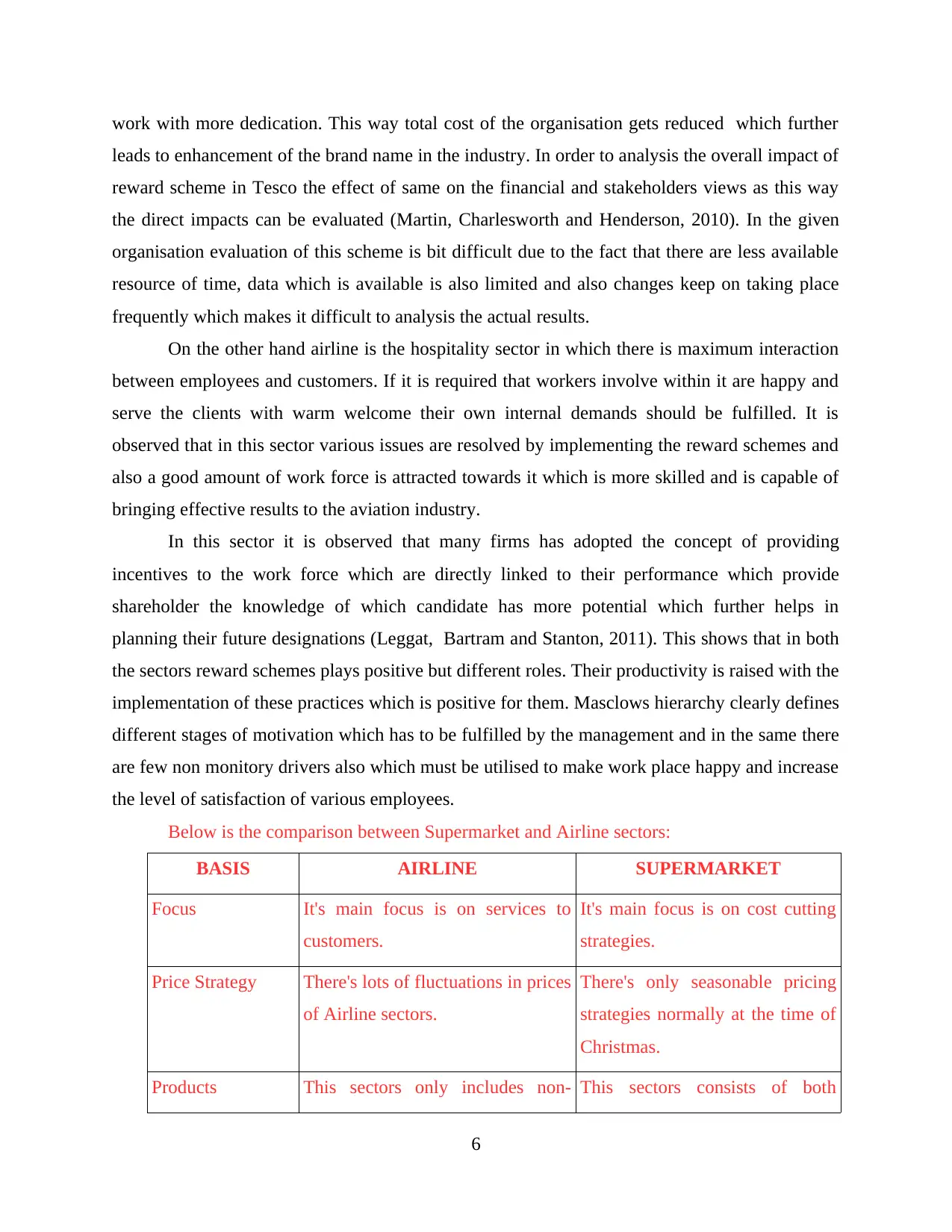
work with more dedication. This way total cost of the organisation gets reduced which further
leads to enhancement of the brand name in the industry. In order to analysis the overall impact of
reward scheme in Tesco the effect of same on the financial and stakeholders views as this way
the direct impacts can be evaluated (Martin, Charlesworth and Henderson, 2010). In the given
organisation evaluation of this scheme is bit difficult due to the fact that there are less available
resource of time, data which is available is also limited and also changes keep on taking place
frequently which makes it difficult to analysis the actual results.
On the other hand airline is the hospitality sector in which there is maximum interaction
between employees and customers. If it is required that workers involve within it are happy and
serve the clients with warm welcome their own internal demands should be fulfilled. It is
observed that in this sector various issues are resolved by implementing the reward schemes and
also a good amount of work force is attracted towards it which is more skilled and is capable of
bringing effective results to the aviation industry.
In this sector it is observed that many firms has adopted the concept of providing
incentives to the work force which are directly linked to their performance which provide
shareholder the knowledge of which candidate has more potential which further helps in
planning their future designations (Leggat, Bartram and Stanton, 2011). This shows that in both
the sectors reward schemes plays positive but different roles. Their productivity is raised with the
implementation of these practices which is positive for them. Masclows hierarchy clearly defines
different stages of motivation which has to be fulfilled by the management and in the same there
are few non monitory drivers also which must be utilised to make work place happy and increase
the level of satisfaction of various employees.
Below is the comparison between Supermarket and Airline sectors:
BASIS AIRLINE SUPERMARKET
Focus It's main focus is on services to
customers.
It's main focus is on cost cutting
strategies.
Price Strategy There's lots of fluctuations in prices
of Airline sectors.
There's only seasonable pricing
strategies normally at the time of
Christmas.
Products This sectors only includes non- This sectors consists of both
6
leads to enhancement of the brand name in the industry. In order to analysis the overall impact of
reward scheme in Tesco the effect of same on the financial and stakeholders views as this way
the direct impacts can be evaluated (Martin, Charlesworth and Henderson, 2010). In the given
organisation evaluation of this scheme is bit difficult due to the fact that there are less available
resource of time, data which is available is also limited and also changes keep on taking place
frequently which makes it difficult to analysis the actual results.
On the other hand airline is the hospitality sector in which there is maximum interaction
between employees and customers. If it is required that workers involve within it are happy and
serve the clients with warm welcome their own internal demands should be fulfilled. It is
observed that in this sector various issues are resolved by implementing the reward schemes and
also a good amount of work force is attracted towards it which is more skilled and is capable of
bringing effective results to the aviation industry.
In this sector it is observed that many firms has adopted the concept of providing
incentives to the work force which are directly linked to their performance which provide
shareholder the knowledge of which candidate has more potential which further helps in
planning their future designations (Leggat, Bartram and Stanton, 2011). This shows that in both
the sectors reward schemes plays positive but different roles. Their productivity is raised with the
implementation of these practices which is positive for them. Masclows hierarchy clearly defines
different stages of motivation which has to be fulfilled by the management and in the same there
are few non monitory drivers also which must be utilised to make work place happy and increase
the level of satisfaction of various employees.
Below is the comparison between Supermarket and Airline sectors:
BASIS AIRLINE SUPERMARKET
Focus It's main focus is on services to
customers.
It's main focus is on cost cutting
strategies.
Price Strategy There's lots of fluctuations in prices
of Airline sectors.
There's only seasonable pricing
strategies normally at the time of
Christmas.
Products This sectors only includes non- This sectors consists of both
6

tangible products. tangible and non-tangible
products both.
If the whole concept of reward schemes is analysed it is observed that management has
various other options also with them to motivate the employees. These are non monitory in
nature still has the capacity to influence the employees to act in the way demanded by
management. In UK the reward scheme is linked with the national minimum wage legislation
which is formulated in order to protect the work force from getting exploited (Miller, and
Tucker, 2013). There it is ensured that every individual gets the fair award for the performance
given by him and no discrimination is done on the grounds of favouritism or like factors. It is
due the reason that this way employees get demotivated and their morale gets affected. Also
turnovers are reduced with the practice of not keeping transparency in the reward schemes and
hence add further different costs (Reeves and et.al., 2011). Each organisation need to work on
developing more and more effective schemes of appraisal as it helps in developing better image
in the market and also develops the chance of hiring better qualified work force. Implementation
of reward schemes effectiveness can be ensured by checking that all data required is available
and enough time is provides to do the evaluation of work force sop that accordingly incentive
plans can be made. As it is a customised tool which operates as per the requirement of the
employees the work of leaders further increases as they need to do close monitoring in this
context.
CONCLUSION
From the above discussed text this has been summarised that to achieve the organisation
goals it is necessary that the employees working within it are motivated. For same reward
schemes is one of the major tool that can be used by leaders as this way workers feel recognised
and hence give more better results with the provided resources. If this technique is successfully
implemented in the organisations than its capacity to use the given resources increases. The
given report shows that motivation has become very crucial in the present competitive world as
if the work force is not happy with the working culture or if their desires remain unfulfilled than
it gives negative impact on the results of enterprise. Reward scheme is a wide concept which is
directly associated to the motivating theories and help leaders in minimising the labour turnover
ration within the commercial enterprise. Apart from this, the given report also suggests how
7
products both.
If the whole concept of reward schemes is analysed it is observed that management has
various other options also with them to motivate the employees. These are non monitory in
nature still has the capacity to influence the employees to act in the way demanded by
management. In UK the reward scheme is linked with the national minimum wage legislation
which is formulated in order to protect the work force from getting exploited (Miller, and
Tucker, 2013). There it is ensured that every individual gets the fair award for the performance
given by him and no discrimination is done on the grounds of favouritism or like factors. It is
due the reason that this way employees get demotivated and their morale gets affected. Also
turnovers are reduced with the practice of not keeping transparency in the reward schemes and
hence add further different costs (Reeves and et.al., 2011). Each organisation need to work on
developing more and more effective schemes of appraisal as it helps in developing better image
in the market and also develops the chance of hiring better qualified work force. Implementation
of reward schemes effectiveness can be ensured by checking that all data required is available
and enough time is provides to do the evaluation of work force sop that accordingly incentive
plans can be made. As it is a customised tool which operates as per the requirement of the
employees the work of leaders further increases as they need to do close monitoring in this
context.
CONCLUSION
From the above discussed text this has been summarised that to achieve the organisation
goals it is necessary that the employees working within it are motivated. For same reward
schemes is one of the major tool that can be used by leaders as this way workers feel recognised
and hence give more better results with the provided resources. If this technique is successfully
implemented in the organisations than its capacity to use the given resources increases. The
given report shows that motivation has become very crucial in the present competitive world as
if the work force is not happy with the working culture or if their desires remain unfulfilled than
it gives negative impact on the results of enterprise. Reward scheme is a wide concept which is
directly associated to the motivating theories and help leaders in minimising the labour turnover
ration within the commercial enterprise. Apart from this, the given report also suggests how
7
⊘ This is a preview!⊘
Do you want full access?
Subscribe today to unlock all pages.

Trusted by 1+ million students worldwide
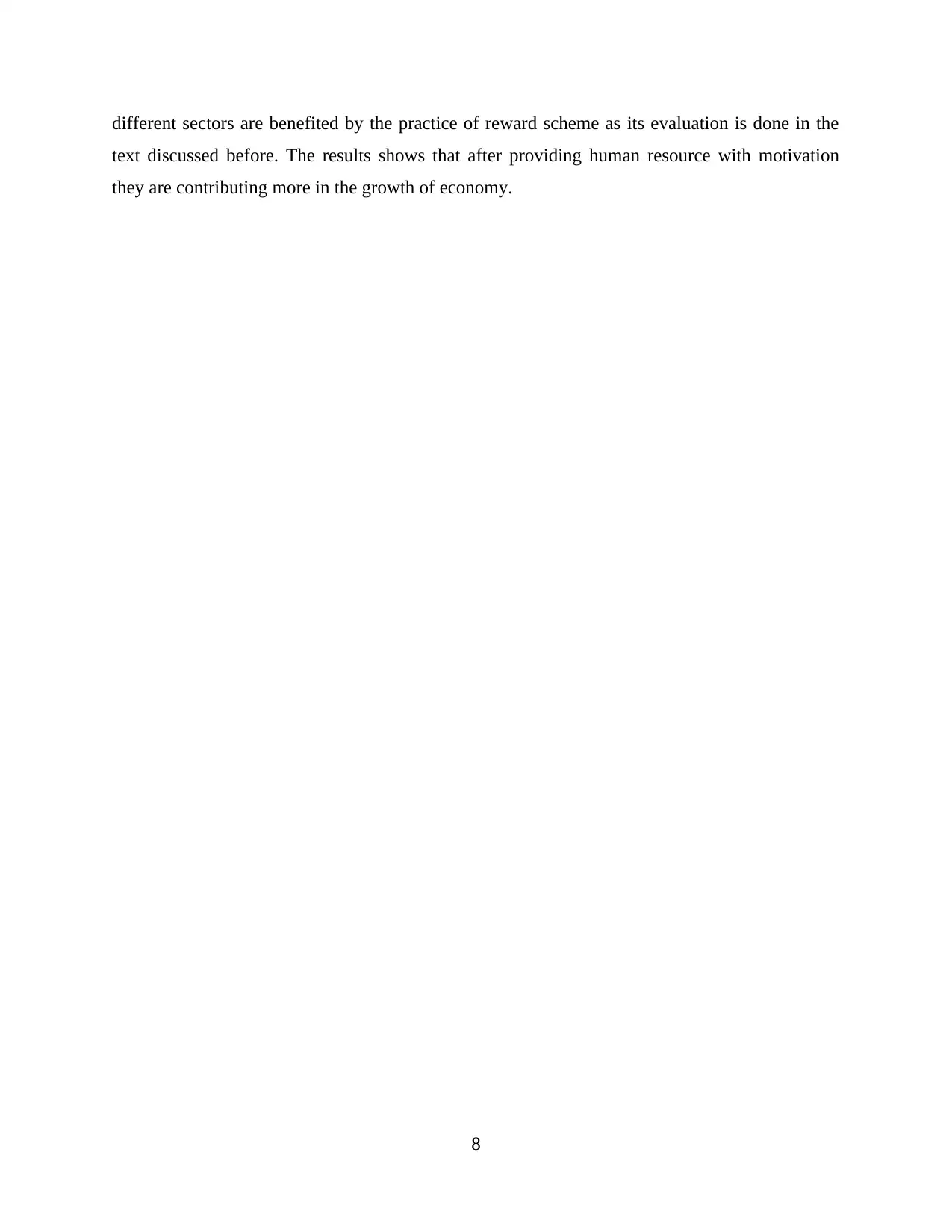
different sectors are benefited by the practice of reward scheme as its evaluation is done in the
text discussed before. The results shows that after providing human resource with motivation
they are contributing more in the growth of economy.
8
text discussed before. The results shows that after providing human resource with motivation
they are contributing more in the growth of economy.
8
Paraphrase This Document
Need a fresh take? Get an instant paraphrase of this document with our AI Paraphraser
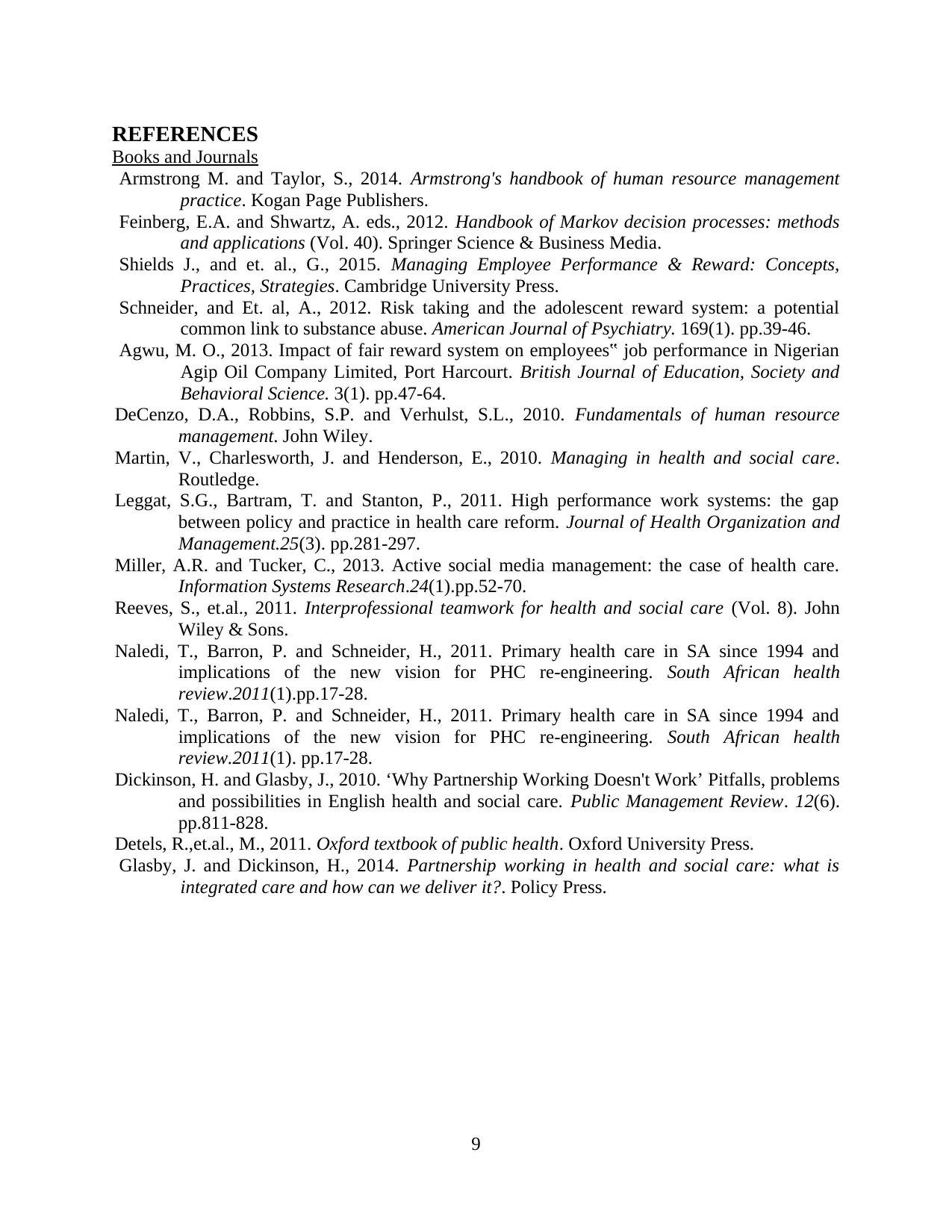
REFERENCES
Books and Journals
Armstrong M. and Taylor, S., 2014. Armstrong's handbook of human resource management
practice. Kogan Page Publishers.
Feinberg, E.A. and Shwartz, A. eds., 2012. Handbook of Markov decision processes: methods
and applications (Vol. 40). Springer Science & Business Media.
Shields J., and et. al., G., 2015. Managing Employee Performance & Reward: Concepts,
Practices, Strategies. Cambridge University Press.
Schneider, and Et. al, A., 2012. Risk taking and the adolescent reward system: a potential
common link to substance abuse. American Journal of Psychiatry. 169(1). pp.39-46.
Agwu, M. O., 2013. Impact of fair reward system on employees‟ job performance in Nigerian
Agip Oil Company Limited, Port Harcourt. British Journal of Education, Society and
Behavioral Science. 3(1). pp.47-64.
DeCenzo, D.A., Robbins, S.P. and Verhulst, S.L., 2010. Fundamentals of human resource
management. John Wiley.
Martin, V., Charlesworth, J. and Henderson, E., 2010. Managing in health and social care.
Routledge.
Leggat, S.G., Bartram, T. and Stanton, P., 2011. High performance work systems: the gap
between policy and practice in health care reform. Journal of Health Organization and
Management.25(3). pp.281-297.
Miller, A.R. and Tucker, C., 2013. Active social media management: the case of health care.
Information Systems Research.24(1).pp.52-70.
Reeves, S., et.al., 2011. Interprofessional teamwork for health and social care (Vol. 8). John
Wiley & Sons.
Naledi, T., Barron, P. and Schneider, H., 2011. Primary health care in SA since 1994 and
implications of the new vision for PHC re-engineering. South African health
review.2011(1).pp.17-28.
Naledi, T., Barron, P. and Schneider, H., 2011. Primary health care in SA since 1994 and
implications of the new vision for PHC re-engineering. South African health
review.2011(1). pp.17-28.
Dickinson, H. and Glasby, J., 2010. ‘Why Partnership Working Doesn't Work’ Pitfalls, problems
and possibilities in English health and social care. Public Management Review. 12(6).
pp.811-828.
Detels, R.,et.al., M., 2011. Oxford textbook of public health. Oxford University Press.
Glasby, J. and Dickinson, H., 2014. Partnership working in health and social care: what is
integrated care and how can we deliver it?. Policy Press.
9
Books and Journals
Armstrong M. and Taylor, S., 2014. Armstrong's handbook of human resource management
practice. Kogan Page Publishers.
Feinberg, E.A. and Shwartz, A. eds., 2012. Handbook of Markov decision processes: methods
and applications (Vol. 40). Springer Science & Business Media.
Shields J., and et. al., G., 2015. Managing Employee Performance & Reward: Concepts,
Practices, Strategies. Cambridge University Press.
Schneider, and Et. al, A., 2012. Risk taking and the adolescent reward system: a potential
common link to substance abuse. American Journal of Psychiatry. 169(1). pp.39-46.
Agwu, M. O., 2013. Impact of fair reward system on employees‟ job performance in Nigerian
Agip Oil Company Limited, Port Harcourt. British Journal of Education, Society and
Behavioral Science. 3(1). pp.47-64.
DeCenzo, D.A., Robbins, S.P. and Verhulst, S.L., 2010. Fundamentals of human resource
management. John Wiley.
Martin, V., Charlesworth, J. and Henderson, E., 2010. Managing in health and social care.
Routledge.
Leggat, S.G., Bartram, T. and Stanton, P., 2011. High performance work systems: the gap
between policy and practice in health care reform. Journal of Health Organization and
Management.25(3). pp.281-297.
Miller, A.R. and Tucker, C., 2013. Active social media management: the case of health care.
Information Systems Research.24(1).pp.52-70.
Reeves, S., et.al., 2011. Interprofessional teamwork for health and social care (Vol. 8). John
Wiley & Sons.
Naledi, T., Barron, P. and Schneider, H., 2011. Primary health care in SA since 1994 and
implications of the new vision for PHC re-engineering. South African health
review.2011(1).pp.17-28.
Naledi, T., Barron, P. and Schneider, H., 2011. Primary health care in SA since 1994 and
implications of the new vision for PHC re-engineering. South African health
review.2011(1). pp.17-28.
Dickinson, H. and Glasby, J., 2010. ‘Why Partnership Working Doesn't Work’ Pitfalls, problems
and possibilities in English health and social care. Public Management Review. 12(6).
pp.811-828.
Detels, R.,et.al., M., 2011. Oxford textbook of public health. Oxford University Press.
Glasby, J. and Dickinson, H., 2014. Partnership working in health and social care: what is
integrated care and how can we deliver it?. Policy Press.
9

10
⊘ This is a preview!⊘
Do you want full access?
Subscribe today to unlock all pages.

Trusted by 1+ million students worldwide
1 out of 13
Related Documents
Your All-in-One AI-Powered Toolkit for Academic Success.
+13062052269
info@desklib.com
Available 24*7 on WhatsApp / Email
![[object Object]](/_next/static/media/star-bottom.7253800d.svg)
Unlock your academic potential
Copyright © 2020–2025 A2Z Services. All Rights Reserved. Developed and managed by ZUCOL.





